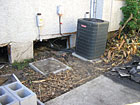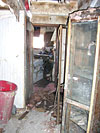
New homes in New Orleans will replace flood-damaged homes like this, which were not built with the convenience of servicing mechanical HVAC systems.
NEW ORLEANS - For HVAC contractors, trying to find the right angle to sell to new home builders and remodelers can be challenging. Some contractors don’t even want to bother with the efforts because they give up what little control they may have in the process and don’t see enough profits to remain a player.
Other contractors specialize in new construction and stay busy year-round. In today’s shaky economy, even new construction contractors are placing more emphasis on service and replacement while others play the waiting game, hoping that plummeting new home sales figures will rise again.
Now add one more negative to the mix - a natural disaster the magnitude of Hurricane Katrina. The devastation brought on to the people of the Gulf Coast has completely changed the dynamics of the region, prompting changes to building codes and giving new definitions to insurance coverage. Amid all of the chaos following Katrina is the need for people to rebuild their homes and lives, including hundreds of thousands of people who must upgrade their rebuilt or new homes or relocate out of the area they have called home for their entire lives.
The saga will continue to play out for many years, but for now, businesses like those in the HVAC trade must deal with the realities of rebuilding their own businesses as well as the neighborhoods in which their customers reside.
Andy McQuaid, general manager of Colgan/Ferguson of Metairie, La., the York distributor in the New Orleans area, spoke withThe NEWSabout the business climate in New Orleans immediately after Katrina and as it is today. York dealer Dwayne Mayeux of Mayeux’s A/C & Heating Inc., Norco, La., also spoke about how he approaches new home builders and remodelers.
THROUGH THE CHAOS
McQuaid said the first 12 months after Katrina were a whirlwind. Some HVAC contractors closed up and there was an accelerated buying of companies. Some who left were small mom-and-pops that got flooded out and “they gave their customer lists to some of the larger companies in a buyout,” added McQuaid. “Three or four of the real big companies gobbled up a bunch.”There was more retrofit and rehab work than there were people to do the work. McQuaid said his revenues were up 30 percent for the year after and some distributors saw revenues reach 50 percent increases. “Residential work was priority,” he said. “York had its best year the 12 months after Katrina, especially because a lot of brand new units were flooded and had to be replaced. The demand for HVAC replacement was incredible. A lot of contractors weren’t even coming out to give quotes. They would just tell the customer they would be available in a couple of weeks.”
Mayeux kept very busy, too. “Immediately after the storm, we increased both our residential and commercial business,” he said. “It has also benefited our employees, who are in demand, and whose pay scale has now risen about 25 percent.”
The fact that so many workers were busy replacing their customers’ equipment kept them away from another developing problem - finding subcontractors to work on new home construction. So many homes were completely inundated with floodwaters that they had to be torn down and replaced. Yet there weren’t enough workers to go around to work on the new homes.
Large builders from out of state, like KB Home, came in to construct new homes but instead of finding local HVAC contractors to subcontract, they had to bring in people from out of town. In a nutshell, HVAC installers and technicians were a hot commodity.
But that wouldn’t last.

The challenge for new home builders will be to replace flood-damaged homes like this with more green homes and higher-efficiency mechanical HVAC systems.
THE SECOND 12 MONTHS
As New Orleans’ residents found out that they didn’t have flood insurance and they would only be covered for wind and rain damage, the sudden surge of reconstruction slowed down. Now residents with a home that had been valued for $400,000 were only getting $150,000 from their insurance company, according to McQuaid. People simply did not have the money to rebuild, so many walked away.Today, a city that once had 1 million residents has dwindled to a population of 650,000. Brand-new homes in developments like KB Home’s River Garden neighborhood are sitting vacant. It’s a tough time to be a builder in New Orleans, said McQuaid. “There are still tons of homes that are boarded up and we are talking about $300,000-$500,000 homes to HUD homes because people didn’t have flood insurance,” he said.
The second 12 months were not good because of the economy, 13 SEER, and new stricter building codes, to name a few issues. “We went from being very lenient on codes in Louisiana to being more strict because the eyes of nation were on us now,” said McQuaid. “Inspections went way up.”
Even people who did get insurance settlements struggled with upgrading their equipment. “The majority of the jobs that we were involved in did not yield enough money in insurance settlements to allow the homeowners to upgrade to higher-efficiency equipment,” said Mayeux. “Plus, we found the homeowners spending dollars out of their own pockets for enhancements like garden tubs and state-of-the-art appliances.”
But the news isn’t all bad. The flood managed to wipe out homes that were built in the ’70s, when efficiency and IAQ were foreign words. Now the returning homeowners have a chance to rebuild with all of the newest technology and with an eye toward the green movement.
“Higher SEER and IAQ are now given more attention than pre-Katrina days,” said McQuaid. “The mold situation because of the flooding brought new attention to IAQ. The green movement has more of an impact because homes from the ’70s were destroyed and now they can be replaced with newer homes with better insulation, windows, etc. Old World New Orleans is catching up on some of the new stuff.”
SELLING THE NEW STUFF
Mayeux said he has followed a specific game plan to market his products and services to home builders and remodelers. He said it is all about being visible.“We aggressively marketed the builders through the local Home Builders Association (HBA) in New Orleans,” Mayeux said. “The influx of out-of-state remodelers proposed a challenge since they mainly operated from their truck and cell phone.
“From a commercial standpoint, our association with the Associated Builders and Contractors (ABC) gave us credibility. When out-of-state commercial contractors came into the area, the ABC office was usually the first place they called - and we got the lead.”
Mayeux said that part of his marketing game plan is to be involved in continuing education for local builders, providing them with information on high-efficiency products, the importance of humidity control, and other updated information.
Mayeux also credits the role of McQuaid during the rebuilding process, adding, “Our distributor has the ability and resources to host some of these seminars for builders. Also, the co-op dollars help us double our investment in builder awareness.”
Now that homes are being rebuilt to different codes and more stringent inspections, this tends to have a positive effect on what HVAC contractors can do, according to McQuaid. “It is easier to access the mechanical system now, as opposed to small crawlspaces in older homes; and guys can get a little creative with systems,” he said. “Besides, retrofits were too costly in old homes.”
Mayeux sees a new upswing in the demand for multifamily dwellings, and he is gearing some of his marketing efforts in that direction, too. “We have the opportunity to work on several large multifamily dwelling units for the city of New Orleans,” he said. “This market has continued to grow since Katrina. We are now marketing to large multi-family builders as well as individual home builders.”
McQuaid noted that before Katrina, there wasn’t much room for new developments in the almost fully developed region. But not now. “Now a lot of these homes have been wiped out and need to be replaced by new neighborhoods,” he said.
ADVICE TO CONTRACTORS
Most contractors do not have to face the challenges of rebuilding after a disaster, but Mayeux gave some advice for anyone who is seeking to work with local builders and remodelers.“The HBA has chapters in every major U.S. city,” he said. “I would suggest that contractors become members and be active. This puts you in front of the builders that will do the majority of the rebuilding. And make sure that out-of-state contractors are licensed by your state and insured.”
McQuaid said that contractors should also be aware of the financial burdens that face people who are rebuilding their homes. “Offer financing,” he said. “It is as important now as it ever has been.”
Mayeux put things into perspective. “The rebuilding of a city is an extremely lengthy process,” he said. “We view it as a marathon and not a sprint. It is important to maintain continuity with your customers and continuing to service them, regardless of how busy you are.
“Continue marketing during the rebuilding process and focus on your products, services, longevity, reputation, and your commitment to rebuild your community.”
Publication Date:02/11/2008

Report Abusive Comment